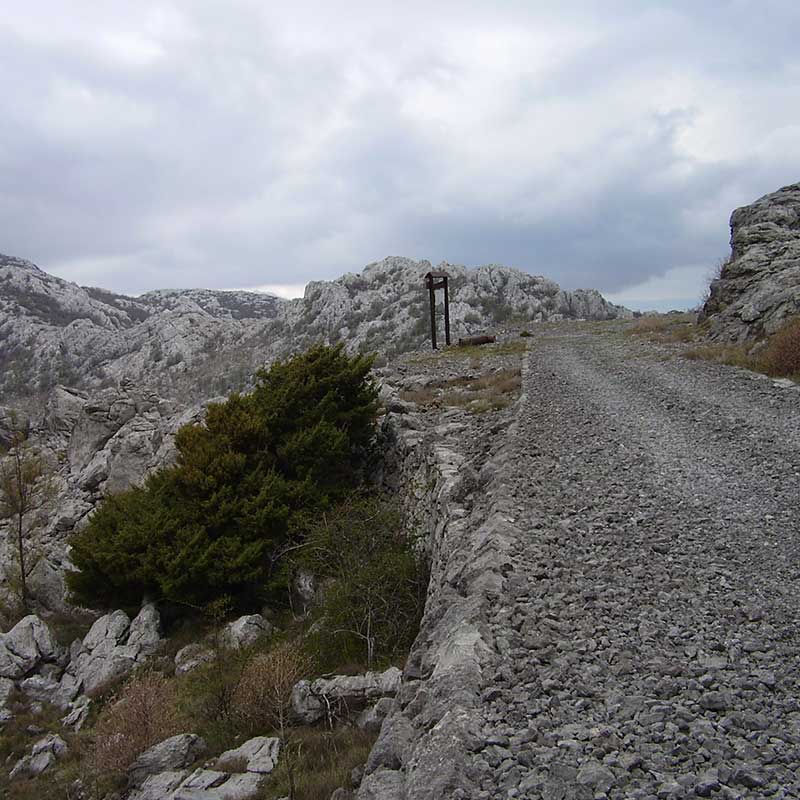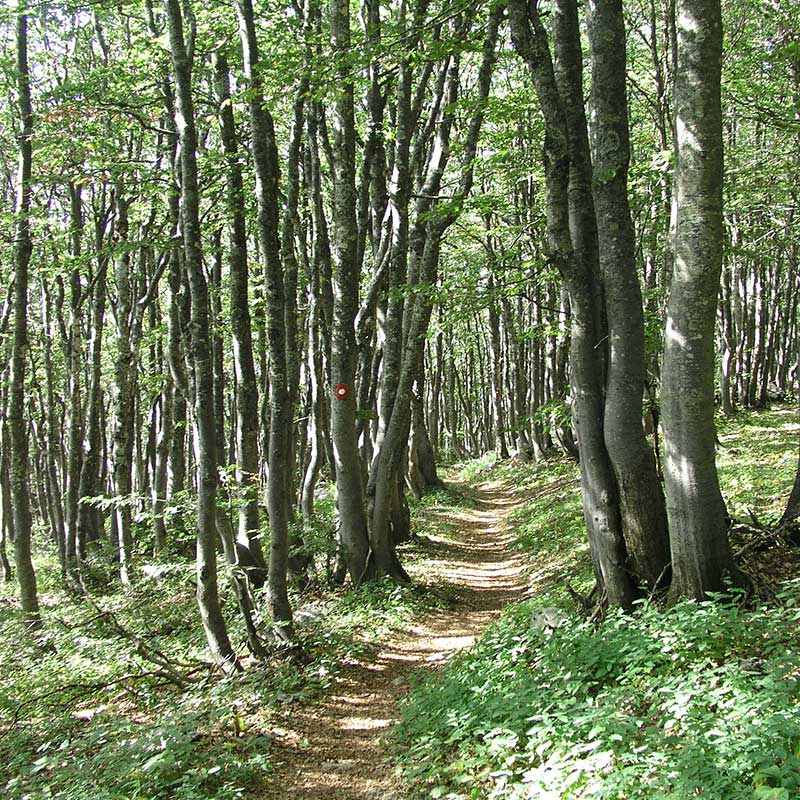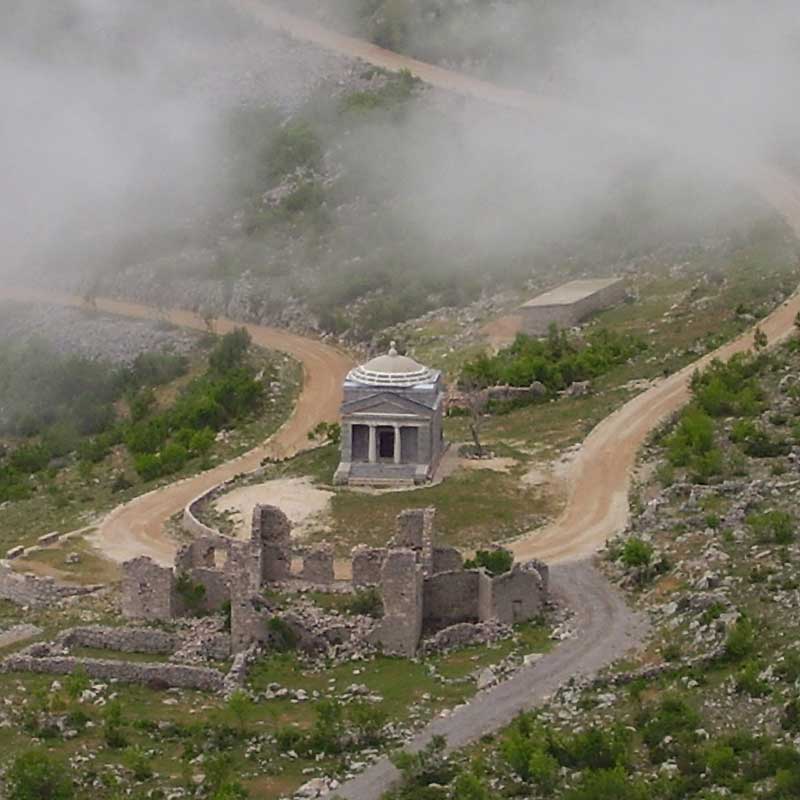Historical roads of Velebit
Velebit has always connected the coastal regions with the hinterland of Lika into an integral economic, cultural and historical unit. Its roads were used for the exchange of various goods. Road connections have therefore been of utmost importance, since the Classical antiquity until the present day.
Aiming to develop the economy, trade and transport, the Habsburg Monarchy built several important roads across Velebit in the 18th and 19th century. The constructors of roads were true experts, so most of these roads are still in use, with only an occasional reconstruction in the meantime.
Back when they were built, the roads of Velebit constituted a major step forward in terms of road quality, due to the fact that their surface was made of stone, with large stone edges, massive reinforcement walls, good road drainage and accompanying facilities, and road width was between four and six meters. The stone road surface was necessary in order to preserve the road against the destructive forces of precipitation waters and strong winds, as it would otherwise soon fall into disrepair.
Due to their good conservation and historical value, some of these roads have been proclaimed cultural goods of the Republic of Croatia.
Theresiana Road
It is one of the most important mountain passes built across Velebit with the aim of facilitating trade between the coastal areas and the mainland.
Theresiana was built in 1786, in order to better link the then military center of Gospić with the free port town of Karlobag, replacing the existing Karolinska Road and its challenging sharp bends and steep sections. The order to build a new, more modern road was issued by the then Austrian Emperor, Joseph II. The road was named after his mother, Maria Theresa.
The construction of the road was entrusted to the frontier officer Filip Vukasović, who later became a renowned builder of the Louisiana Road between the cities of Karlovac and Rijeka.
In 2007, Theresiana became part of the list of cultural goods of the Republic of Croatia.
In order to acquaint as many visitors as possible with the cultural value of Theresiana, the Public Institution in charge of the Velebit Nature Park built an educational trail on one section of the road. The trail is intended solely for walking, and it is particularly interesting due to the diversity of the area it passes through. Although only three kilometers long, the trail provides insight into both faces of Velebit in their full splendor.
Premužić Trail
This mountain trail, 57 kilometers long, connects the peak areas of northern and central Velebit, from the area of Zavižan to Baške Oštarije. It is named after its designer, Ante Premužić, a renowned constructor of paths and trails on Velebit.
The construction of the trail made it possible to approach the most inaccessible and beautiful parts of Velebit, known only to very few inhabitants prior to the trail. It took merely three years (from 1930 to 1933) to construct the trail, and the works were performed by many inhabitants of the villages on both sides of Velebit.
Since there are no steep climbs, even people unaccustomed to mountain climbing can pass the trail. They can rest in several mountain lodges located near the trail.
Due to its quality of construction and the way it blends into the natural environment, this trail is considered to be a masterpiece of construction. That is precisely why it became part of the list of cultural goods of the Republic of Croatia in 2009.
Majstorska Road
Another historical road of Velebit included in the list of cultural goods of the Republic of Croatia (in 2007) is the so-called Majstorska Road.
The construction of this road across Velebit built on the route Sveti Rok – Mali Alan – Obrovac began in 1825, with the aim of shortening the travel time to Dalmatia. It is the road where the renowned builder of mountain roads, frontier officer Josip Kajetan Knežić, began his independent career.
The construction of this 41-kilometer long road was completed in 1832, when the opening ceremony was held, and the road was named Majstorska cesta, or Master’s Road. Namely, the manner in which J.K. Knežić designed the route along the steep slopes of Velebit, with numerous hairpin bends between the canyons and the peaks, represented a masterful achievement in road construction. The maximum inclination of the road was 5.5%, which is within limits of even the current regulations on road construction. Since its beginnings, this new road of Velebit was used not only for trade, but also for postal transport between Vienna and Zadar.
The road passes next to a significant geomorphological locality of Tulove grede – a pronounced group of vertical limestone blocks, peaks and towers.
1730. - 1735.
Put Gospić-Oštarije-Karlobag
1730. - 1735.
1750.-1754.
Stara Karolina
Gospić-Oštarije-Karlobag
1775. - 1779.
Jozefina
Karlovac-Žuta Lokva-Vratnik-Senj <small>100 km</small>
1775. - 1779.
1783.-1786
Senj-Sv.Juraj <small>10 km</small>
1784. - 1786.
Terezijana
Gospić-Oštarije-Karlobag <small>33 km</small>
1784. - 1786.
1785. - 1789.
Dalmatinska cesta
Žuta Lokva-Gospić-Gračac-Zrmanja-Pađene 159 km
1787.
Rekonstrukcija dijela Jozefine
Vratnik - Oštro - Sv. Križ
1787.








